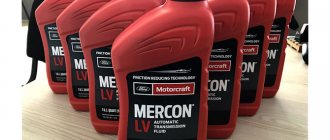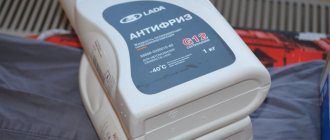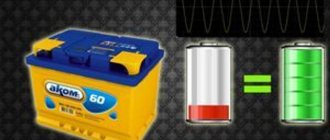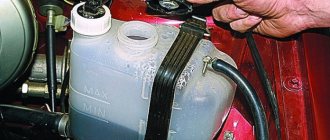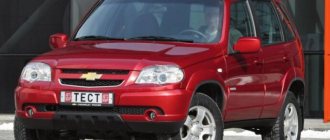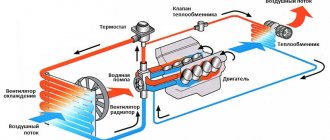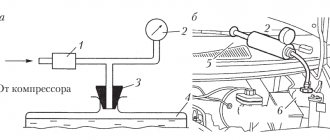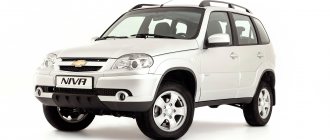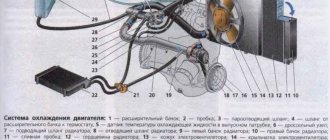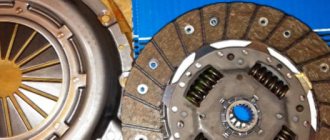Niva Chevrolet: cooling system
Engine operation at normal temperature conditions is ensured by the functioning of the components included in its composition . This is a closed-type pipeline with forced ventilation.
List of elements providing heat exchange:
- Pump for pumping water.
- Thermostat.
- Fans.
- Radiator.
- Expansion tank.
The pump operates under the influence of centrifugal force . As the blades rotate, coolant is pumped, creating a pressure difference, so the antifreeze moves along the line.
For the efficient functioning of the heat exchanger, which includes a radiator, a thermostat is provided to open and close the movement of coolant in a circle. The latter is necessary to maintain balance in the system and has factory settings - it opens at a temperature range from 75 to 80°C.
The radiator contains two tanks connected horizontally by aluminum channels:
- one receives coolant;
- from the other - coolant comes out.
Heat exchange is provided over the radiator area.
When heated, a liquid tends to expand. To avoid the creation of excess pressure, an expansion tank is designed to receive it . The latter is equipped with a cover with a bypass valve to increase the pressure in the system. By switching to a closed type, it was possible to increase the boiling point and eliminate losses due to leakage from the tank.
Motor oils
| Oil brand | SAE viscosity grade | Group | Manufacturer | Regulatory document | |
| AAI | AP1 | ||||
| LUKOIL LUX | 5W-30, 5W-40 10W-40,15W-40 | B5/D3 | SJ/CF | LLC "Lukoil-Permnefteorg-sintez", Perm | STO 00044434-003 |
| LUKOIL LUX | 0W-40, 5W-20, 5W-30, 5W-50, 10W-30 | B5/D3 | SL/CF | LLC "Lukoil-Permnefteorg-sintez", Perm | STO 00044434-003 |
| TNK SUPER | 5W-30, 5W-40 10W-40 | B5/D3 | SJ/SL/CF | TNK Lubricants LLC, Ryazan | TU 0253-008-44918199 |
| TNK MAGNUM | 5W-30, 5W-40 10W-40,15W-40 | B5/D3 | SJ/SL/CF | TNK Lubricants LLC, Ryazan | TU 0253-025-44918199 |
| ROSNEFT MAXIMUM | 5W-40, 10W-40 | B5/D3 | SL/CF | OJSC "Novokuibyshevsk Oil and Additives Plant", Novokuibyshevsk | TU 0253-063-48120848 |
| ROSNEFT OPTIMUM | 10W-30, 10W-40 15W-40 | B5/D3 | SJ/CF | OJSC "Novokuibyshevsk Oil and Additives Plant", Novokuibyshevsk | TU 0253-062-48120848 |
| ROSNEFT MAXIMUM | 5W-40, 10W-40 | B5/D3 | SL/CF | OJSC "Angarsk Petrochemical Company", Angarsk | TU 0253-391-05742746 |
| ROSNEFT OPTIMUM | 10W-30, 10W-40 15W-40 | B5/D3 | SJ/CF | OJSC "Angarsk Petrochemical Company", Angarsk | TU 0253-389-05742746 |
| ROSNEFT PREMIUM | 0W-40, 5W-40 5W-40 | B5/D3 | SJ/CF SL/CF SM/CF | OJSC "Angarsk Petrochemical Company", Angarsk | TU 0253-390-05742746 |
Continuation of the table. 2
| Oil brand | SAE viscosity grade | Group | Manufacturer | Regulatory document | |
| AAI | API | ||||
| EXTRA 1 EXTRA 5 EXTRA 7 | 5W-30 15W-40 20W-50 | B5/D3 | SJ/CF | OJSC "Omsk Oil Refinery", Omsk | TU 38.301-19-137 |
| EXTRA | 5W-30, 10W-40, 15W-40 | B5/D3 | SL/CF | OJSC "Omsk Oil Refinery", Omsk | TU 38.301-19-137 |
| ESSO ULTRA | 10W-40 | B5/D3 | SJ/SL/CF | Exxon-Mobil, Germany | |
| GTTURBO SM | 10W-40 | B5 | S.M. | Hanval INC, Korea | |
| LIQUI MOLY OPTIMAL | 10W-40 | B5/D3 | SL/CF | Liqui Moly GmbH, Germany | |
| MOBIL 1 MOBIL SYNT S MOBIL SUPER S | 0W-40, 5W-50 5W-40 10W-40 | B5/D3 | SJ/SL SM/CF SJ/SL/CF | Exxon-Mobil, Germany | |
| MOBIL 1 ESP FORMULA | 5W-30 | B6/D3 | SJ/SL SM/CF | ||
| RAVENOL HPS RAVENOL VSI RAVENOL LLO RAVENOL TSI RAVENOL Turbo-C HD-C | 5W-30 5W-40 10W-40 10W-40 15W-40 | B5/D3 | SL/CF SL/CF SL/CF SL/CF SJ/CF | Ravensberger Schmirstoffvertrieb GmbH, Germany | |
| SHELL HELIX: PLUS PLUS EXTRA ULTRA | 10W-40 5W-40 5W-40 | B5/D3 | SL/CF | SHELL EAST EUROPE Co, UK, Finland | |
| ZIC A PLUS | 5W-30, 10W-30, 10W-40 | B5 | SL | SK CORPORATION, Korea | |
How much antifreeze is in the cooling system, volume table
According to information about car maintenance, antifreeze should be changed after the car has driven 60 thousand km. Antifreeze becomes unusable after a run of 20 thousand km .
Important. It is better to give the choice of coolant in favor of concentrate. The main advantage is that it can be diluted in the required proportion, since after flushing, distilled water remains in the system.
An excellent choice is the product Castrol Radicool SF . If you give preference to a ready-made product, it is recommended to choose AGA Z4, G12 Re or FELIX Carbox G12+.
Table (Niva Chevrolet) antifreeze volume:
| Car model name | Engine capacity | Indicator of liters of coolant in the system | Coolant and its analogues |
| Niva Chevrolet | 1.7 l | 8.2 l |
|
Fuel tank characteristics
The fuel tank of this model has almost sixty liters, or more precisely 58. On average, per hundred kilometers you have to spend 8-9 liters of AI-95, Premium-95 or AI-92 gasoline. Features of the fuel container:
- the tank is located directly under the rear seat;
- in the upper part there is a small hatch under which the fuel pump is installed;
- The sensor will help determine the level of fuel fluid and the amount of gasoline.
There are other Chevrolet Niva filling tanks , many of which are included in various systems.
What coolant is recommended for Chevrolet Niva
The best option when choosing a coolant would be products containing:
- propylene glycol or ethylene glycol (aggressive substance);
- distilled water;
- additives (silicate, carbosilicate or hybrid).
Products with carbosilite additives have excellent heat transfer, increased cooling temperatures and a long service life ; they also prevent the formation of fatty deposits. Silicate additives help reduce temperature and cause rust.
Important! A high-quality coolant must have increased thermal conductivity and a high boiling point. During operation, foam and scale should not form, and in the cold season the liquid should not freeze.
Antifreeze G12 is ideal for a Niva Chevrolet car . The coolant is replaced every 2 years or after 60 thousand km. If the color of the fluid has changed, this is another reason to replace the coolant. When acquiring a reddish tone, you should pay attention that the chemical properties of the composition have changed.
Features and purpose of filling containers
Refueling tanks are sealed tanks, hoses and other vehicle elements designed to contain and circulate fuel and lubricants. Timely changes of oil in the gearbox and engine of the car, as well as filling brake and coolant fluid, will extend the life of the Chevy Niva SUV and increase its safety while driving. The accessible placement of filling containers will allow them to be repaired without leaving the garage.
This is interesting: What is the fuel consumption of a loaf?
Replacement frequency - what antifreeze to fill
Coolant gradually loses its properties as it constantly circulates inside the car system. Thermal conductivity is lost, the level of inhibitors decreases and foaming begins.
If the antifreeze is not replaced in a timely manner, this may cause metal corrosion and engine overheating.
Replacement times depend on:
- Product quality.
- Vehicle operating conditions.
The procedure is carried out on average once every 2-3 years . According to the established regulations, antifreeze is replaced every five years or after a mileage of 250,000 km per year.
But in some cases this period is reduced for the following reasons :
- Presence of sediment or cloudiness in the expansion tank.
- A deposit of a jelly-like mass has formed on the inside of the tank, near the neck. Even if this is noticeable at subzero temperatures, there is a need for replacement.
Attention! If the antifreeze has turned brown or rusty in color, then it must be replaced urgently, as the metal has begun to actively rust.
The volume of coolant poured depends on the engine volume and is 6.3-10 liters.
Determining the level
Before refueling, it is recommended to determine the oil level in the car:
1. Open the hood and find the inspection hole - there you will see a dipstick for measuring the oil level in the engine (it is located in the middle of the cylinder block on the breather cover of the crankcase ventilation system);
2. Remove the dipstick and wipe it with a cloth to remove any remaining oil;
3. Insert the dipstick back, and after 5-10 seconds, remove it again - normally the oil should be between o and “MAX”.
Other section materials
| Appendix 1. Tightening torques for threaded connections Appendix 2. Basic data for adjustments and control Appendix 3. Fuels and lubricants… |
| Gap between the spark plug electrodes, mm1.00-1.15 Free play of the steering wheel in a position corresponding to straight movement, degrees... |
| Name Type Headlamp unit: high beam lamp, low beam lamp, turn signal lamp, side light lamp AKG 12-55 (H1)… |
| Appendix 6. Electrical diagram of VAZ-2123 cars: 1 – right headlight; 2 – sound signal; 3 – engine compartment lamp; 4 – switch… |
| Part Thread Tightening torque, N m (kgf m) Engine Main bearing cap mounting bolt M10x1.2568.31-84.38 (6.97-8.61… |
| Place for lubrication, refueling and processingNameGOST, TUApplicationMotor gasolineFuel tankPremium-95 (Ai-95)RON 95… |
| Appendix 7. Electrical connection diagram of the ECM: 1 – controller; 2 – electric fan of the engine cooling system, right; 3 – electric fan… |
| Fuel tank 58.0 Engine cooling system 8.0 Engine lubrication system 3.75 Gearbox housing 1.6 Housing… |
Gear diagram
Shifting gears is the same as on most cars. This was done with the goal of unifying vehicles so that drivers, when changing to another car, experience as few problems as possible.
But, at the same time, there are some differences in the design of this car. The transmission on the Niva Chevrolet is equipped with two levers. The first is necessary to select the optimal gear. The second is necessary to activate the differential lock.
It indicates the maximum speed specific to each specific gear. When it is reached, you need to switch to a higher one.
Classification of the VAG concern
The most popular classification is the Volkswagen-Audi tolerance system. Now they have changed the designations, but everyone basically writes these “mysterious symbols” on the cans.
G11 – ethylene glycol base, the cheapest coolant, with a small package of additives. Usually blue-green in color. Russian analogue of "Tosol". Action: covers ALL walls of the cooling system with a thin film, which should protect against corrosion. The disadvantage is that this film is a very good thermal insulator and quite significantly reduces the efficiency of the cooling system. Recommended service life is 2 years (data taken from the German directory). One year of operation in Germany is equivalent to 20 thousand km, but whether the car was parked or driven does not matter.
G12 – base ethylene glycol, additives – carboxylate compounds. Usually red. It acts locally on areas of corrosion and for this reason has significantly better heat removal. Long-playing. Service life without loss of characteristics is more than 5 years. G12+ - polypropylene glycol base. The color is usually orange. Made for the sake of the environment. Non-toxic, can decompose naturally in nature. The boiling point of this antifreeze is increased to 135 degrees.
Neste antifreeze, concentrate
Freezing and crystallization. What is it and what is the difference. According to our GOSTs there is no difference, but according to Western standards there is. Crystallization temperature is the state at which crystals begin to form in a liquid. Ice slush forms. The freezing point is the point at which antifreeze becomes a “solid state.” It does not harden like ice, but rather looks like cooled semolina or oatmeal (whoever liked which one more in kindergarten). For the antifreeze I presented in this article, the crystallization temperature is minus 35, the pour point is minus 42.
ready antifreeze Total
What to choose for bridges
In most cases, the oil chosen for axles is the same as for the transfer case. Their full compliance guarantees you high functionality of all components of the transmission during active daily use of the car. Most car enthusiasts agree that you should only buy proven lubricants. These include products from the following brands:
- Castrol;
- Lukoil;
- Liqui Moly;
- Mobil;
- Shell;
This is a list of the most popular and widely used brands. Their products are used by a huge number of car enthusiasts with different experience levels. When purchasing, be sure to check the compatibility of the viscosity and chemical composition with the oil already used in the gearbox.
Malfunctions
Problems with the gearbox can be identified by several signs. The most common ones are:
- transmission noise
- Difficulty shifting gears
- spontaneous shutdown
- oil leaks on the body
Also on restyled models, a knock appears in the transmission after 5-10 thousand kilometers. In this case, it is necessary to pay attention to the conditions under which the knocking appears.
In rare cases, the link fails. This is the unit that is responsible for the interaction between the Niva 21214 transmission and the rod. There are 3 main signs that the malfunction is associated with this particular unit:
- Large lever play
- Problems when selecting gear
- Inability to adjust the mechanism
All problems arising with the Chevrolet transmission require immediate elimination, since this directly affects not only the serviceability of the vehicle but also traffic safety.
